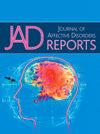Content-specificity of a single-session cognitive bias modification of interpretations for social anxiety
Q3 Psychology
引用次数: 0
Abstract
Cognitive bias modification of Interpretations (CBM-I) has been proposed as a promising mechanistically-focused intervention for social anxiety disorder (SAD). Although CBM-I modifies the interpretation biases associated with SAD, the effect sizes for symptomatic improvements are small. The efficacy of CBM-I may be improved by tailoring the content of the intervention to the targeted disorder (i.e., content-specificity). The current study examined whether content-specific CBM-I was associated with improved bias and symptom outcomes compared to non-content-specific CBM-I. Participants (N = 108, aged 18–35, M = 19.00, SD = 2.44) with elevated social anxiety symptoms were randomly allocated to receive a single session of content-specific or non-content-specific CBM-I. The content-specific group had significantly greater reductions in negative interpretation bias and social interaction anxiety symptoms than the non-content-specific group. There were no group differences for social observation anxiety. However, the non-content-specific group had a significantly larger reduction in state anxiety than the content-specific group. The results indicated that CBM-I for SAD may be improved by matching the content of the intervention to the disorder. Future research should replicate the results using multiple sessions and consider the importance of tailoring CBM-I to diagnostic presentation and specific biases.
社交焦虑解释的单次认知偏差修正的内容特异性
认知偏差修正解释(CBM-I)被认为是一种有前途的针对社交焦虑障碍(SAD)的机械干预方法。虽然CBM-I修正了与SAD相关的解释偏差,但症状改善的效应量很小。CBM-I的疗效可以通过针对目标障碍量身定制干预内容(即内容特异性)来提高。目前的研究检查了与非内容特异性CBM-I相比,内容特异性CBM-I是否与改善偏倚和症状结果相关。社交焦虑症状升高的参与者(N = 108,年龄18-35岁,M = 19.00, SD = 2.44)被随机分配接受单次内容特异性或非内容特异性CBM-I。与非特定内容组相比,特定内容组在负面解释偏差和社交焦虑症状方面的减少显著更大。社会观察焦虑无组间差异。然而,与特定内容组相比,非特定内容组在状态焦虑方面的下降幅度要大得多。结果表明,通过将干预内容与障碍相匹配,可以改善SAD的CBM-I。未来的研究应该使用多个疗程来重复结果,并考虑调整CBM-I以适应诊断表现和特定偏差的重要性。
本文章由计算机程序翻译,如有差异,请以英文原文为准。
求助全文
约1分钟内获得全文
求助全文
来源期刊

Journal of Affective Disorders Reports
Psychology-Clinical Psychology
CiteScore
3.80
自引率
0.00%
发文量
137
审稿时长
134 days
 求助内容:
求助内容: 应助结果提醒方式:
应助结果提醒方式:


